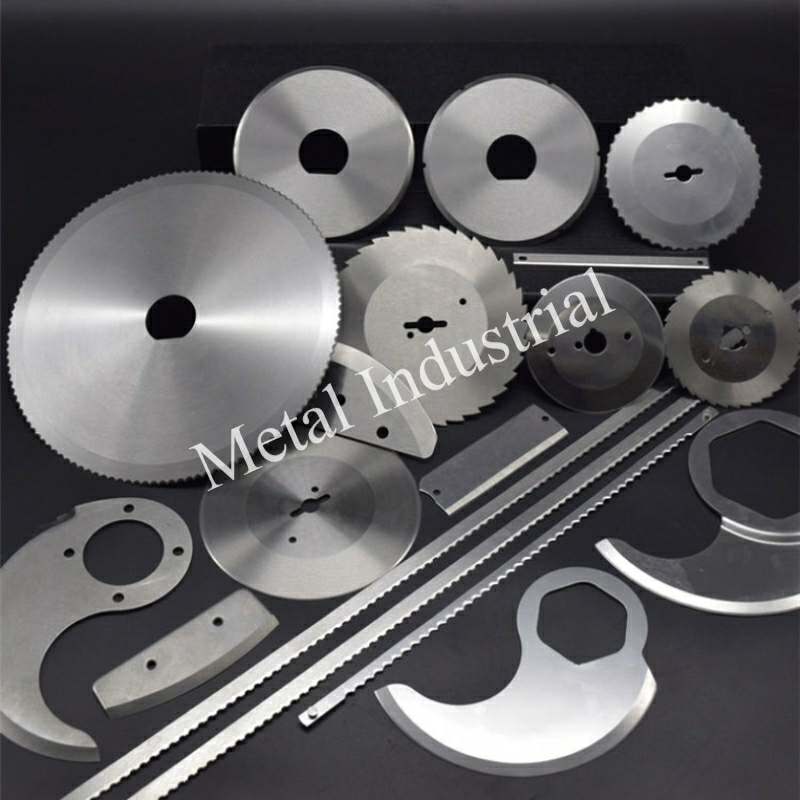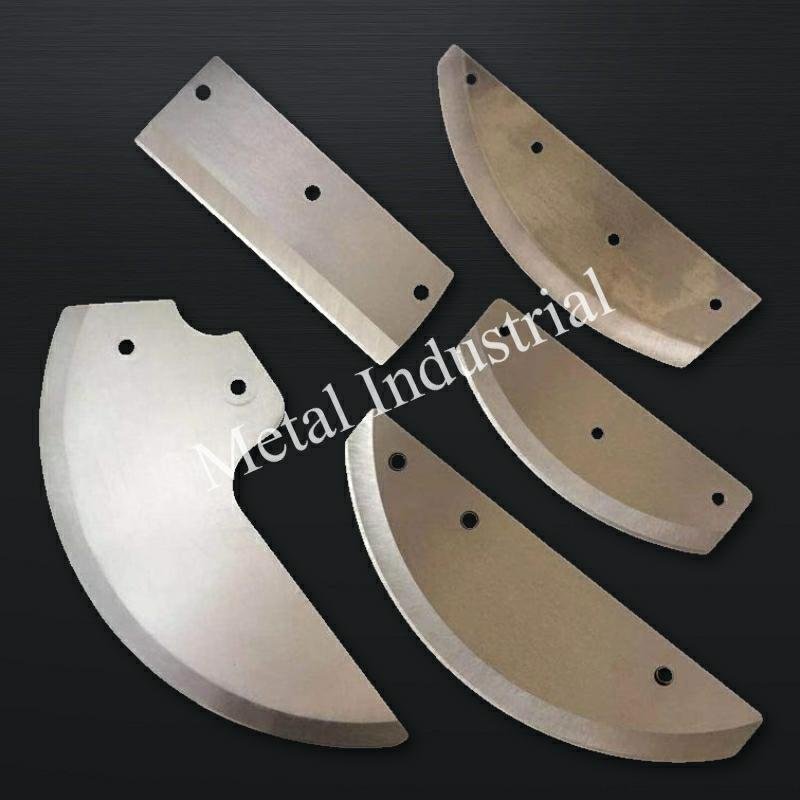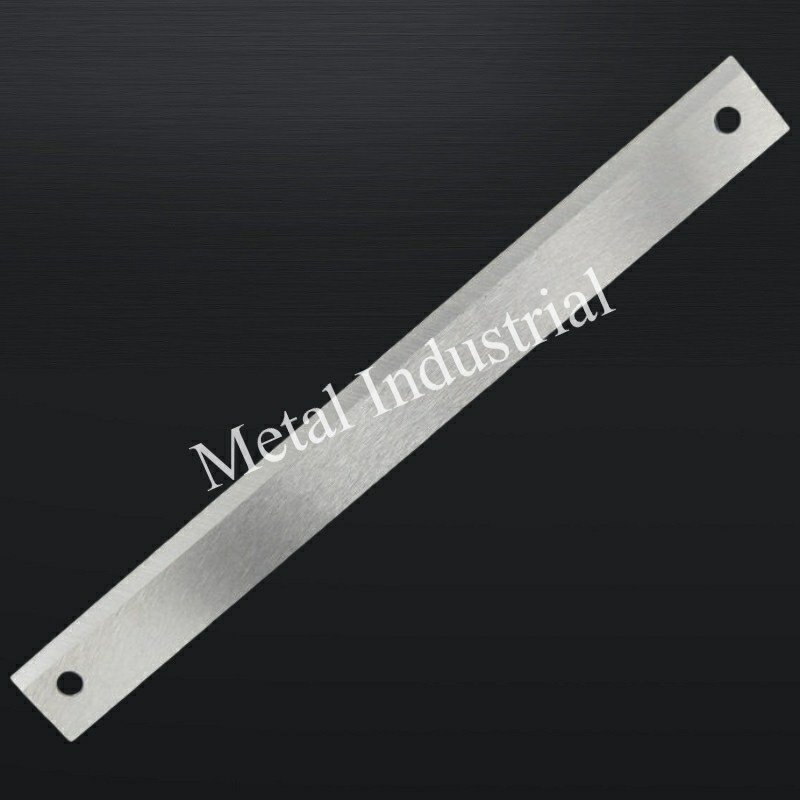
No mundo acelerado do processamento de frutas e vegetais, a eficiência é primordial. À medida que a demanda por produtos pré-embalados e prontos para consumo continua a aumentar, os processadores estão sob crescente pressão para atender às expectativas do consumidor e aos padrões da indústria. Um fator-chave para atingir essa eficiência está no processo de corte — especificamente, as lâminas usadas para fatiar e picar os produtos. Se suas lâminas de corte não estiverem à altura da tarefa, isso pode levar a atrasos, desperdício de recursos e qualidade inconsistente do produto. É aí que entram as lâminas de corte de alto desempenho, oferecendo uma solução que aumenta a produtividade e reduz os custos operacionais.
Neste artigo, exploraremos a importância de lâminas de corte na indústria de processamento de alimentos, os benefícios das lâminas de alto desempenho e como elas podem resolver problemas comuns enfrentados pelos processadores. No final, você terá uma melhor compreensão de como investir nas ferramentas de corte certas pode revolucionar seu negócio. Continue lendo para descobrir como otimizar seus processos!
A importância da eficiência no processamento de frutas e vegetais
A indústria de processamento de frutas e vegetais enfrenta inúmeros desafios, especialmente à medida que a demanda por produtos prontos para consumo de alta qualidade aumenta. Os processadores devem equilibrar velocidade com precisão, ao mesmo tempo em que atendem a rigorosos padrões de segurança e qualidade de alimentos. Vamos explorar alguns dos principais desafios:
Desafios da indústria:
- Aumento da demanda: Os consumidores estão cada vez mais buscando frutas e vegetais pré-cortados e pré-embalados para maior conveniência. Isso exige ciclos de produção mais rápidos sem comprometer a qualidade.
- Redução de Resíduos: O desperdício de alimentos é uma preocupação significativa, com muitos processadores enfrentando metas rigorosas de redução de desperdício. As lâminas de corte devem garantir que cada fatia seja o mais eficiente possível para minimizar o desperdício.
- Mantendo a Qualidade: Cortes de alta qualidade não apenas melhoram o apelo do produto, mas também garantem uniformidade, o que é essencial para atender aos padrões da indústria e às expectativas dos clientes.
Ineficiências em qualquer uma dessas áreas podem rapidamente levar a custos operacionais mais altos, atrasos e uma reputação manchada. Investir em lâminas de corte de alto desempenho é uma maneira eficaz de enfrentar esses desafios de frente, garantindo que seus processos permaneçam eficientes, econômicos e de alta qualidade.

Por que as lâminas de corte são essenciais para a eficiência
No processamento de frutas e vegetais, as lâminas de corte são as heroínas anônimas. Elas desempenham um papel fundamental em tudo, desde a velocidade de corte até a consistência do produto final. Veja como elas influenciam a eficiência:
Função principal das lâminas:
- Velocidade: Quanto mais afiada e durável for a lâmina, mais rápido ela poderá processar os produtos, reduzindo o tempo de inatividade e aumentando a produtividade.
- Precisão: Uma lâmina de alto desempenho garante cortes limpos e uniformes, o que é crucial para atender aos padrões de qualidade e reduzir o desperdício de produto.
- Redução de Resíduos: Com melhores ferramentas de corte, menos material é desperdiçado durante o processo de fatiamento, resultando em maiores rendimentos e menos perda de produto.
Problemas com lâminas padrão:
- Embotamento frequente: As lâminas padrão perdem o fio rapidamente, exigindo substituições frequentes e afetando a consistência dos cortes.
- Qualidade inconsistente: Lâminas de baixa qualidade tendem a produzir cortes irregulares ou irregulares, diminuindo a aparência e a qualidade do produto.
- Desgaste e corrosão: Em ambientes com alta umidade e limpeza frequente, as lâminas tradicionais podem sofrer ferrugem ou corrosão, causando problemas de desempenho.
Para obter resultados ideais, a qualidade das suas lâminas de corte deve corresponder às demandas da sua linha de processamento. Lâminas de corte de alto desempenho resolver esses problemas proporcionando maior afiação duradoura, cortes consistentes e resistência ao desgaste.
Características das lâminas de corte de alto desempenho
Nem todas as lâminas são criadas iguais. Lâminas de corte de alto desempenho são projetados com materiais e engenharia avançados para atender às rigorosas demandas do processamento de frutas e vegetais. Vamos mergulhar nas principais características que fazem essas lâminas se destacarem:
Excelência material:
- Aço inoxidável: Resistente à corrosão e durável, o que o torna ideal para ambientes onde as lâminas são expostas à umidade e à limpeza frequente.
- Carboneto de tungstênio: Conhecidas por sua dureza excepcional, as lâminas de carboneto de tungstênio mantêm o fio por períodos mais longos e exigem afiação menos frequente.
- Lâminas Cerâmicas: Leves, não reativas e resistentes à corrosão, as lâminas de cerâmica são uma ótima escolha para produtos delicados, como ervas ou vegetais folhosos.
Engenharia de Precisão:
- Nitidez: As lâminas de alto desempenho são projetadas para permanecerem afiadas por mais tempo, garantindo cortes limpos com o mínimo de esforço.
- Personalização: As lâminas podem ser adaptadas a diferentes tipos de produtos, garantindo desempenho de corte ideal para cada item na linha de processamento.
Longevidade e manutenção:
- Vida útil estendida: Ao contrário das lâminas padrão, as lâminas de corte de alto desempenho podem durar mais, reduzindo o tempo de inatividade para substituição da lâmina.
- Manutenção fácil: Essas lâminas são mais fáceis de manter e exigem menos substituições, o que se traduz em custos mais baixos e menos interrupções no seu fluxo de trabalho de processamento.
Benefícios das lâminas de corte de alto desempenho
Investindo em lâminas de corte de alto desempenho traz inúmeros benefícios que impactam diretamente suas operações e seus resultados financeiros. Veja como eles fazem a diferença:
Velocidade de processamento aprimorada:
Lâminas de alto desempenho garantem corte mais rápido com resistência mínima. Isso reduz o tempo necessário para processar cada lote, permitindo que sua operação atinja as metas de produção mais facilmente. O processamento mais rápido leva a um tempo de resposta mais rápido e maior produção.

Redução de resíduos:
Cortes de precisão minimizam o desperdício de produtos. Ao cortar de forma consistente e limpa, essas lâminas garantem que menos peças sejam descartadas devido a imperfeições ou danos. O resultado? Menos desperdício de alimentos, uso mais eficiente de recursos e lucratividade melhorada.
Melhoria da qualidade do produto:
Cortes uniformes melhoram o apelo estético dos seus produtos, o que é crucial para a satisfação do consumidor. Cortes consistentes e de alta qualidade não apenas atendem aos padrões da indústria, mas também melhoram o apelo visual do produto, tornando-o mais atraente para os clientes.
Eficiência de custos:
Embora lâminas de corte de alto desempenho possam ter um custo inicial mais alto, elas economizam dinheiro a longo prazo, reduzindo a frequência de substituições, melhorando a eficiência operacional e minimizando o tempo de inatividade.
Como escolher as lâminas de corte certas
Escolhendo o certo lâminas de corte de alto desempenho para suas necessidades de processamento de frutas e vegetais é uma decisão crítica que impacta tanto a eficiência quanto a qualidade do produto. Aqui está um guia detalhado sobre como fazer a melhor escolha, com fatores específicos a serem considerados:
1. Material da lâmina
O material das suas lâminas de corte é um dos fatores mais importantes para determinar seu desempenho, durabilidade e requisitos de manutenção. Diferentes materiais oferecem vários benefícios dependendo do ambiente de processamento, tipo de produto e uso esperado.
| Material da lâmina | Vantagens | Melhor para | Aplicações típicas |
| Aço inoxidável | Resistente à corrosão, fácil de limpar, durável | Processamento padrão de frutas e vegetais | Folhas verdes, maçãs, pepinos, cenouras |
| Carboneto de tungstênio | Extremamente duro, mantém o fio afiado por mais tempo, durável | Operações de alto volume e trabalho pesado | Batatas, vegetais de raiz, abóbora, tomates |
| Cerâmica | Leve, não reativo, resistente à corrosão | Produtos delicados | Ervas, frutas vermelhas (por exemplo, tomates, frutas vermelhas) |
| Aço carbono | Resistente, econômico, afia facilmente | Uso geral, operações de baixo custo | Processos de corte em pequena escala ou manuais |
Principais considerações:
- Resistência à corrosão: Se você estiver lidando com ambientes de alta umidade (o que é comum no processamento de frutas e vegetais), lâminas de aço inoxidável e cerâmica são ideais para evitar ferrugem e corrosão.
- Durabilidade: O carboneto de tungstênio é o material mais durável, durando mais e permanecendo afiado por períodos mais longos, o que o torna uma boa escolha para linhas de corte pesadas que processam grandes volumes de produtos.
- Produtos Específicos: Frutas e vegetais diferentes requerem tipos diferentes de lâminas. Por exemplo, produtos mais macios (como frutas vermelhas) se beneficiam de lâminas de cerâmica, enquanto vegetais duros (como cenouras e batatas) têm melhor desempenho com lâminas de carboneto de tungstênio.

2. Design e personalização da lâmina
O design da lâmina é crucial para atingir alta eficiência e qualidade de corte consistente. A maioria das lâminas de alto desempenho são personalizáveis para corresponder aos requisitos específicos da linha de processamento.
| Característica do design da lâmina | Impacto no desempenho | Formulários |
| Formato do dente | Afeta a velocidade e a precisão do corte. Dentes serrilhados são ideais para vegetais duros, enquanto lâminas lisas são melhores para frutas macias. | Vegetais duros como cenoura, beterraba e raízes. |
| Espessura da lâmina | Lâminas mais finas reduzem o desperdício de material e aumentam a velocidade de corte, mas podem ser mais propensas a danos. Lâminas mais grossas são mais duráveis. | Ambientes de corte de alto volume. |
| Ângulo da lâmina | Um ângulo mais agudo oferece mais precisão, enquanto um ângulo mais cego oferece maior durabilidade e é mais fácil de manter. | Cortes precisos para folhas verdes ou frutas delicadas. |
| Multiuso vs. Uso único | Lâminas multiuso são versáteis, mas menos eficientes em tarefas específicas em comparação às lâminas de uso único, que são projetadas para cortes especializados. | Lâminas de uso único para cortes consistentes e de alta qualidade de frutas ou vegetais específicos. |
3. Durabilidade e dureza
A dureza do material de uma lâmina impacta sua capacidade de manter o fio e resistir ao desgaste. O carboneto de tungstênio, por exemplo, tem uma classificação de dureza de 9 na escala de Mohs (de 10), o que significa que é altamente resistente ao desgaste. Isso o torna uma ótima escolha para operações com alto rendimento ou para aquelas que cortam produtos mais resistentes.
4. Compatibilidade com máquinas de corte
Nem todas as lâminas são compatíveis com todos os tipos de máquinas de corte. Considere o tipo de máquina que você está usando (por exemplo, cortadores rotativos, cortadores de guilhotina ou fatiadores) e garanta que as lâminas sejam projetadas para trabalhar com essas máquinas específicas. Lâmina personalizada Os fornecedores geralmente fornecem soluções personalizadas para atender às necessidades de máquinas específicas, melhorando o desempenho e reduzindo o desgaste.
Lâminas de corte de alto desempenho: manutenção e cuidados
Para maximizar a vida útil e o desempenho de lâminas de corte de alto desempenho, manutenção e cuidados adequados são essenciais.
Manutenção de rotina:
- Limpeza: A limpeza regular previne o acúmulo de resíduos, que pode causar embotamento ou corrosão. Use soluções de limpeza adequadas e garanta que as lâminas estejam completamente secas após cada sessão de limpeza.
- Lubrificação: Peças móveis requerem lubrificação para minimizar o atrito e o desgaste. Isso é especialmente importante para máquinas que usam lâminas rotativas.
Medidas preventivas:
- Inspeção: Inspecione regularmente as lâminas para sinais de desgaste, como lascas ou rachaduras. Lidar com pequenos problemas antes que eles se tornem grandes problemas pode estender a vida útil da lâmina e reduzir o tempo de inatividade.
- Afiação: Dependendo do material e do uso, algumas lâminas podem precisar de afiação. Serviços profissionais de afiação podem restaurar o desempenho da lâmina sem a necessidade de substituição.
Maximizando a vida útil da lâmina:
- Armazenamento adequado: Guarde as lâminas em condições secas e seguras para evitar danos. Use capas protetoras para evitar cortes ou amassados acidentais.
- Manuseio: Sempre manuseie as lâminas com cuidado para evitar acidentes e garantir que elas permaneçam em ótimas condições.

Tendências futuras em lâminas de processamento de frutas e vegetais
A indústria de lâminas de corte está evoluindo. Aqui estão algumas tendências futuras que podem moldar a maneira como as lâminas de corte são usadas no setor de processamento de frutas e vegetais:
Avanços tecnológicos:
- Lâminas inteligentes: A integração de Internet das Coisas (IoT)a tecnologia permite o monitoramento em tempo real do desempenho da lâmina, fornecendo informações valiosas sobre desgaste e otimizando cronogramas de manutenção.
- Otimização de IA:A inteligência artificial está sendo usada para analisar padrões de corte e prever quando as lâminas precisam de manutenção, melhorando a eficiência e minimizando o tempo de inatividade.
Sustentabilidade:
À medida que a sustentabilidade se torna uma preocupação crescente na fabricação, mais empresas estão se concentrando na criação de lâminas de corte ecologicamente corretas. Isso inclui usar materiais recicláveis e reduzir o desperdício durante o processo de fabricação.
Automação:
Com o aumento da automação no processamento de alimentos, as lâminas farão cada vez mais parte de sistemas totalmente automatizados, incluindo afiação e substituição automáticas. Isso simplificará ainda mais as operações e melhorará a eficiência.
Estudos de caso e histórias de sucesso
Para compreender melhor os benefícios práticos de lâminas de corte de alto desempenho, vamos dar uma olhada em alguns exemplos da vida real. Esses estudos de caso mostram como várias empresas melhoraram sua eficiência de processamento, reduziram custos e melhoraram a qualidade do produto por meio do uso de tecnologias avançadas de corte.
Estudo de caso 1: Melhorando a velocidade e reduzindo o desperdício em “Produtos frescos da fazenda“
Problema: A FarmFresh Produce, uma grande empresa de processamento de frutas, estava enfrentando altos custos operacionais devido ao desperdício excessivo e ao tempo de inatividade frequente da máquina causado por lâminas de corte cegas. A empresa estava processando uma ampla variedade de frutas, de maçãs a frutas vermelhas, o que exigia diferentes tipos de lâminas. Suas lâminas atuais, feitas de aço inoxidável padrão, não estavam fornecendo a durabilidade necessária para operações de alto volume.
Solução:A empresa mudou para lâminas de corte de alto desempenho em carboneto de tungstênio, que foram especialmente projetadas para alto rendimento e resistentes ao desgaste. As lâminas também foram personalizadas para se adequarem ao produto específico sendo processado.
Resultados:
- Velocidade de processamento: As novas lâminas aumentaram a velocidade de processamento em 25%, pois mantiveram o fio afiado por mais tempo, reduzindo o tempo de inatividade da máquina.
- Redução de Resíduos: O desperdício diminuiu em 18%, pois os cortes mais limpos garantiram danos mínimos ao produto.
- Economia de custos: A FarmFresh Produce economizou 12% anualmente em substituições de lâminas e custos de manutenção.
- Qualidade do produto: A uniformidade dos cortes melhorou, resultando em maior satisfação do cliente e melhor prazo de validade.
Dados-chave:
| Métrica | Antes da implementação | Após a implementação |
| Velocidade de processamento | 200 unidades por hora | 250 unidades por hora |
| Redução de Resíduos | 10% de produtos desperdiçados | 8.2% de produtos desperdiçados |
| Frequência de substituição da lâmina | A cada 6 meses | A cada 12 meses |
| Economia anual no custo da lâmina | N / D | 12% economia |
Conclusão: Ao mudar para lâminas de corte de alto desempenhoA FarmFresh Produce melhorou significativamente sua eficiência operacional, reduzindo desperdícios e custos, além de melhorar a qualidade do produto.

Estudo de caso 2: Controle de qualidade e aumento de produtividade na “GreenGro”
Problema: A GreenGro, uma processadora especializada em folhas verdes e saladas pré-cortadas, teve dificuldades para manter a consistência do corte e a qualidade do produto. Suas lâminas estavam causando cortes irregulares que resultavam em aparência irregular do produto, o que afetava a satisfação do consumidor.
Solução: GreenGro mudou para lâminas de corte de cerâmica de alto desempenho, conhecidas por sua afiação e capacidade de fazer cortes suaves e limpos. Essas lâminas foram personalizadas para cortar vegetais folhosos com o mínimo de esmagamento ou contusão.
Resultados:
- Melhoria da qualidade do produto: Os cortes mais limpos e suaves aumentaram o apelo do produto e reduziram o número de itens rejeitados.
- Aumento da produtividade: As novas lâminas permitiram velocidades de corte mais rápidas, o que aumentou a produtividade em 20%.
- Satisfação do cliente: As pontuações de satisfação do cliente aumentaram em 15% devido à melhoria da qualidade das saladas embaladas.
Dados-chave:
| Métrica | Antes da implementação | Após a implementação |
| Taxa de transferência | 1.000 maços por dia | 1.200 maços por dia |
| Taxa de rejeição | 5% de produção total | 3% de produção total |
| Satisfação do cliente | Feedback positivo 80% | 95% feedback positivo |
| Economia de custos anuais | N / D | 10% economia em resíduos e mão de obra |
Conclusão: As lâminas de corte de cerâmica de alto desempenho permitiram que a GreenGro melhorasse a qualidade do produto e a eficiência do processamento, gerando melhor feedback do cliente e aumentando a produtividade.
Estudo de caso 3: Escalonamento da produção na “VeggiePro”
Problema: A VeggiePro, uma processadora de vegetais de alto volume, estava procurando escalar a produção para sua crescente base de clientes. No entanto, suas lâminas padrão não conseguiam atender às demandas de produção contínua em larga escala, levando a um tempo de inatividade significativo e frequentes substituições de lâminas.
Solução: VeggiePro optou por lâminas de carboneto de tungstênio projetados para produção em alto volume, com um revestimento que aumenta sua resistência ao desgaste.
Resultados:
- Aumento da capacidade de produção: Capacidade de produção aumentada em 30%, permitindo que a VeggiePro atendesse à crescente demanda dos clientes.
- Eficiência de custos: Os custos de substituição da lâmina diminuíram em 40%, graças à durabilidade do carboneto de tungstênio.
- Tempo de inatividade reduzido: O tempo gasto na substituição de lâminas foi reduzido pela metade, resultando em fluxos de produção mais suaves.
Dados-chave:
| Métrica | Antes da implementação | Após a implementação |
| Capacidade de produção | 10.000 unidades por dia | 13.000 unidades por dia |
| Frequência de substituição da lâmina | A cada 3 meses | A cada 6 meses |
| Economia anual no custo da lâmina | N / D | Poupança 40% |
| Tempo de inatividade | 10 horas por semana | 5 horas por semana |
Conclusão: Carboneto de tungstênio lâminas de corte de alto desempenho forneceu a durabilidade necessária para dimensionar a produção, reduzir o tempo de inatividade e economizar custos, permitindo que a VeggiePro atendesse com eficiência à crescente demanda.
Explore Nanquim Metal's gama de lâminas de corte de alto desempenho
Lâminas de corte de alto desempenho são um divisor de águas para a indústria de processamento de frutas e vegetais. Elas oferecem inúmeros benefícios, desde tempos de processamento mais rápidos e redução de desperdício até melhor qualidade do produto e eficiência de custo. Ao escolher as lâminas certas e mantê-las adequadamente, os processadores podem otimizar suas operações, reduzir o tempo de inatividade e permanecer à frente em um mercado cada vez mais competitivo.
Interessado em atualizar suas ferramentas de corte? Explore nossa gama de lâminas de corte de alto desempenho hoje e veja como eles podem transformar seu negócio. Entre em contato conosco agora para uma consulta ou um teste gratuito do produto!



8 respostas
Este site foi sugerido pelo meu primo. Não tenho certeza se isso
o post foi escrito por ele, pois ninguém mais conhece tantos detalhes sobre o meu problema.
Você é maravilhosa! Obrigada!
Olá pessoal, como vão todos e o que vocês gostariam de dizer sobre isso?
este artigo, na minha opinião, é realmente incrível para mim.
Seu estilo é tão único em comparação com outras pessoas que li
coisas de. Obrigado por postar quando você tiver a oportunidade, Gᥙess
Vou apenas marcar este blog como favorito.
Way coⲟl! Alguns pontos extremamente válidos! Eu aprecio você escrevendo isso
O artigo e o resto do site são extremamente bons.
Acho que esta é uma das informações mais significativas
para mim. E estou feliz em ler seu artigo. Mas deveria
observação sobre algumas coisas gerais, O estilo do site é maravilhoso,
os artigos são muito bons : D. Bom trabalho,
saúde
Logo estou pronto para tomar meu café da manhã, depois de tomar meu
café da manhã chegando novamente para ler mais notícias.
Artigo peculiar, exatamente o que eu estava procurando.
Obrigado